A Neuroscientific investigation of the Interaction between Crowdedness and Environment typology (NICE)
Understanding how the typology (green vs built), design, and crowding in urban spaces interact with the people's affective experience and cognitive performance during active mobility.

When observing the “crowdedness” of different places such as a street in the Central Business District, an underground walkway, or a park, are the pedestrian densities at these places the same? Does pedestrian density influence aesthetic judgements – how much one tends to ‘like’ urban spaces?
In this project, researchers will investigate the interaction between the aesthetic perceptions of the environment, its typology and its congestion by studying the cognitive, affective, and brain correlations in an environmental neuroscience framework.
The researchers will conduct a set of two complementary naturalistic neurophysiological studies, with the aim of understanding the complex interaction between perceptions of crowding and the design and typology of urban public spaces.
A Neuroscientific investigation of the Interaction between Crowdedness and Environment typology (NICE) is motivated by previous studies, which show that exposure to green (compared to built-up) environments (from urban parks to forests) gives rise to psychological benefits such as stress reduction, balancing of emotions and attention processes. Apparently, perceived crowding in different types of spaces has negative cognitive and psychological effects on individuals, which, in turn, is moderated by demographic, cultural, and spatial parameters.
The project extends the research of the recent L2NIC Pedestrian Comfort in High Pedestrian Activity Areas project. While previous research focused on certain specific aspects of crowding or environments, this project will focus on studying these parameters simultaneously to understand how they interact.
The COVID-19 pandemic and the associated mitigation measures have highlighted the important links between urban environments, mental health, and wellbeing at both the individual and societal level.
This project will help scientists and planners to better understand how the aesthetic perceptions and the density of urban spaces interact, in order to promote evidence- informed design and planning decisions to improve our cities.